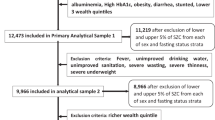Abstract
Total Serum Zinc (TSZn) and albumin were determined, and low molecular weight serum Zn measured by radiochemical Ultra-Filtration (UFSZn) in healthy Dutch infants and children, and in samples obtained from those with diseases that are expected to alter TSZn.
Our control TSZn values, 10.2±3.5 μmol/L, were low compared to those reported in the literature. Variation in serum albumin could not explain this: No correlation of TSZn with serum albumin was found (p>0.5). Likely explanations are the nonfasting state and the stress owing to hospital surroundings at the time of sampling. A range of other influences not registered may be active and are discussed. No significant age-dependence was found (p<0.8). Boys over 9 yr of age showed higher TSZn compared with girls of the same age (p<0.08). In a separate experiment a 17% decrease in TSZn was demonstrated by food intake (eggs). These results support the opinion that TSZn is of little value to measure Zn status. There was no discrimination in TSZn between healthy subjects and patients.
Our UFSZn values, 0.28±0.13 μmol/L in the controls as well as in the patients, were correlated with TSZn and therefore not a suitable alternative for the measurement of TSZn as parameter to determine the Zn status. The UFSZn was not correlated with serum albumin (p>0.7). UFSZn values were higher in infants (p<0.01), no sex dependence was found. We conclude that TSZn as well as UFSZn are of limited clinical relevance.
Similar content being viewed by others
References
B. L. Vallee,J. Inher. Metab. Dis. 6(suppl.),1, 31 (1983).
A. Klug and D. Rhodes,Trends Biochem. Sci. 12, 464 (1987).
M. S. Lee,Science 245, 635 (1989).
R. Berfenstam,Acta Paediatr. 41(suppl.), 87 (1952).
H. H. Hellwege,Monatschr. Kinderheilk. 119, 37 (1971).
K. Kasperek, L. E. Feinendegen, I. Lombeck, and H. J. Bremer,Eur. J. Pediatr. 126, 199 (1977).
R. Laitinen, E. Vuori, S. Dahlström, and H. V. Äkerblom,Ped. Res. 25, 323 (1989).
R. Laitinen,Biol. Trace Elem. Res. 25, 71 (1990).
S. M. Pilch, and R. Senti (eds.),Assessment of the zinc nutritional status of the U.S. population based on data collected in the second national health and nutrition examination survey, 1976–1980. Life Sciences Research Office, FASEB, Bethesda MD (1984).
T. Hongo, T. Suzuki, T. Ohba, K. Karita, Y. Dejima, J. Yoshinaga, M. Togo, H. Ishida, H. Suzuki, and E. Hisatsune,J. Nutr. Sci. Vitaminol. 38, 177 (1992).
H. Fauré, A. Favier, M. Tripier, and J. Arnaud,Biol. Trace Elem. Res. 24, 25 (1990).
J. C. Van Wieringen, M. J. Roede, and J. M. Wit,Tijdschr. Kindergeneesk. 53, 147 (1985).
K. E. C. De Haan, C. J. De Groot, C. J. A. Van den Hamer, and H. Boxma,Clin. Chim. Acta 170, 111 (1987).
R. C. Whitehouse, A. S. Prasad, and Z. T. Cossack,Clin. Chem. 29, 1974 (1983).
E. L. Giroux, D. Durieux, and P. Schechter,Bioinorg. Chem. 5, 211 (1976).
M. Persigehl, A. Höck, K. Kasperek, E. Land, and L. E. Feinendegen,Zeitschr. Klin. Chem. Klin. Biochem. 12, 171 (1974).
D. McMaster, E. McCrum, C. C. Patterson, M. McKerr, D. O'Reilly, A. E. Evans, and A. H. G. Love,Am. J. Clin. Nutr. 56, 440 (1992).
C. E. Casey, P. A. Walravens, and K. M. Hambidge,Am. J. Clin. Nutr. 34, 1443 (1981).
A. S. Prasad,J. Am. Coll. Nutr. 4, 591 (1985).
B. E. Walker, I. Bone, B. H. Mascie-Taylor, and J. Kelleher,Int. J. Vit. Nutr. Res. 49, 413 (1979).
M. E. Markowitz, J. F. Rosen, and M. Mizruchi,Am. J. Clin. Nutr. 41, 689 (1985).
H. Ohno, K. Yamashita, R. Doi, K. Yamamura, T. Kondo, and N. Taniguchi,J. Appl. Physiol. 58(5) 1453 (1985).
J. C. Wallwork,Biol. Trace Elem. Res. 12, 335 (1987).
M. T. Baer, and J. C. King,Am. J. Clin. Nutr. 39, 556 (1984).
J. P. Van Wouwe, H. H. Van Gelderen, and J. H. Bos,Eur. J. Pediatr. 146, 293 (1987).
Author information
Authors and Affiliations
Rights and permissions
About this article
Cite this article
Van Wouwe, J.P., Waser, I. Comparison between total and ultrafiltrable serum zinc as test to diagnose zinc deficiency in infants and children. Biol Trace Elem Res 40, 203–211 (1994). https://doi.org/10.1007/BF02950793
Received:
Accepted:
Issue Date:
DOI: https://doi.org/10.1007/BF02950793




